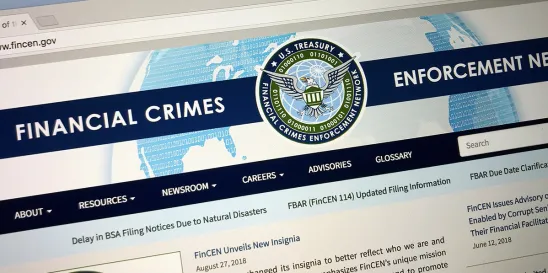The USDT’s report indicated that investment advisers can “serve[] as an entry point into the US market for illicit proceeds associated with foreign corruption, fraud, and tax evasion,” and some investment advisers and their advised funds are “being used by foreign states . . . to access certain technology and services with long-term national security implications through investments in early-stage companies.” The USDT provided a number of reasons why investment advisers may be vulnerable to these types of threats. Among those is that RIAs have historically not had to implement comprehensive anti-money-laundering (AML) and countering the financing of terrorism (CFT) requirements. Because some RIAs and ERAs conduct less, if any, client due diligence, the USDT found that they are an ideal entry point for bad actors to access the US financial system.[1]
FinCEN’s proposed rule would require RIAs and ERAs to implement risk-based AML/CFT programs, file suspicious activity reports (SARs) and currency transaction reports (CTRs) and fulfill recordkeeping requirements and other obligations that are applicable to financial institutions subject to the BSA. These requirements closely align with the AML/CFT rules that banks, broker-dealers, insurance companies, and other financial institutions already follow.
As FinCEN Director Andrea Gacki put it, “[I]nvestment advisers are important gatekeepers to the American economy, overseeing the investment of tens of trillions of dollars. The current patchwork of AML/CFT requirements creates regulatory gaps that criminals and foreign adversaries exploit to launder money, hide illicit wealth, and compromise American innovation.... This proposed rule would level the regulatory playing field, protect US economic and national security, and safeguard American businesses.” To accomplish these goals and provide these protections, something FinCEN has been striving to do for over 20 years, FinCEN has confirmed that finalizing the rule is a priority for the agency.
Proposed Rule
FinCEN has proposed to include RIAs and ERAs in the definition of “financial institution” under the BSA. The proposed rule will require RIAs and ERAs to establish AML/CFT compliance programs, to file SARs and other reports with FinCEN, to comply with certain recordkeeping requirements, and to comply with certain “information-sharing provisions between and among FinCEN, law enforcement government agencies, and certain financial advisors.”
AML/CFT Compliance Program
RIAs and ERAs are obligated under the proposed rule to:
- Develop internal policies, procedures, and controls to prevent and detect money laundering, terrorist financing, and illicit activity.
- Designate an AML/CFT compliance officer who will implement and monitor the internal compliance program.
- Provide ongoing training for personnel within the organization.
- Conduct an independent audit of the AML/CFT program to assess its effectiveness.
- Establish risk-based procedures for ongoing customer due diligence to assist with understanding the purpose of customer relationships, developing customer risk profiles, and monitoring for suspicious activity.
To ensure the AML/CFT program receives buy-in from senior leadership, the program must be approved in writing by the adviser’s board of directors or trustees (or sole proprietor, general partner, trustee, or other persons that have functions similar to a board of directors).
Reporting Obligations
RIAs and ERAs will now be subject to many of the reporting, recordkeeping, and related obligations that the BSA has already placed on other financial institutions, including requirements to:
- File SARs to report any transaction that involves or aggregates at least $5,000 in funds or other assets or a transaction of any size when the adviser “knows, suspects, or has reason to suspect that the transaction (or a pattern of transactions of which the transaction is a part): (1) involves funds derived from illegal activity or is intended or conducted to hide or disguise funds or assets derived from illegal activity as a part of a plan to violate or evade any Federal law or regulation or to avoid any transaction reporting requirement under Federal law or regulation; (2) is designed, whether through structuring or other means, to evade the requirements of the BSA; (3) has no business or apparent lawful purpose, and the investment adviser knows of no reasonable explanation for the transaction after examining the available facts; or (4) involves the use of the investment adviser to facilitate criminal activity.”
- File CTRs (instead of Form 8300s) to report cash transactions of more than $10,000 conducted during a single day.
Other Requirements
The proposed rule also puts in place certain recordkeeping, due diligence, and information sharing requirements. Specifically, RIAs and ERAs must:
- Comply with recordkeeping obligations, including under the travel rule. Under the proposed rule, advisers must create and retain records relating to the transmittals of funds and confirm that the transmitter’s name, address, and other information relating to the transmittal of funds “travel” with the transmittal to the next financial institution in the payment chain.
- Comply with special due diligence requirements of correspondent accounts for foreign financial institutions and private banking accounts.
- Establish procedures for information-sharing in response to regulatory and law enforcement authorities, in accordance with Section 314(a) of the USA PATRIOT Act, as well as for voluntary information-sharing with other financial institutions pursuant to Section 314(b) of the USA PATRIOT Act.
The proposed rule does not apply all of the BSA’s AML/CFT requirements to RIAs and ERAs. Covered investment advisors will not be required to (1) implement a Customer Information Program or (2) collect beneficial ownership data and information for legal entity customers.
Takeaways
FinCEN is accepting comments on the NPRM until April 15.
If the proposed rule is adopted, all RIAs and ERAs will need to evaluate their compliance programs, or establish compliance programs, that meet the new requirements within one year of the effective date of the final rule.
[1] Id. at 4-5.








 />i
/>i
